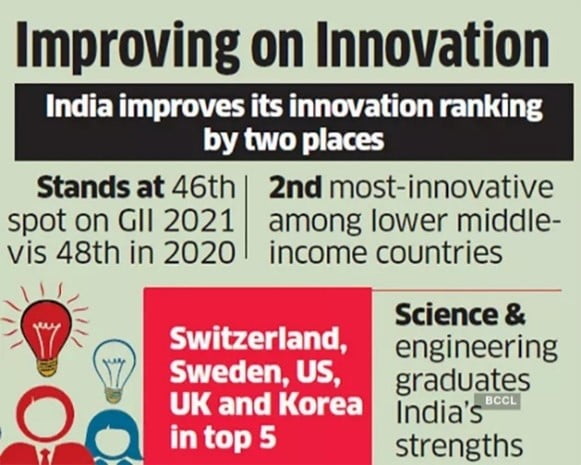Science and Technology
In news: The recent report of the Economic Advisory Council to the Prime Minister (EAC- PM), ‘Why India Needs to Urgently Invest in its Patent Ecosystem?’, highlights the significance of a robust patent system for a knowledge economy and for the promotion of technological innovations.
About India’s Patent Ecosystem
| Total number of patent applications | Increased by 48% between 2010-11 and 2020-21 (Increase largely driven by residents applications) |
| Share of residents in the total number of patent applications filed | More than doubled during the last decade
from 6.4% to 12.2%.
|
| Number of patent applications by residents | First time surpassed foreign applications |
| Share of abandoned patents in the total number of patent applications | Soared from 13.6% in 2010-11 to 48% in 2019-20 |
| Number of patent applications filed by the top 10 academic institutes and universities | Rose by more than two times in four years. |
Important provisions of the Patents Act:
- Section 9(1) – those applications accompanied by provisional specifications be supported by complete specifications within one year.
- Section 21(1) – re-file documents if the patent examiner finds them not meeting the requirements such as when applicants are not confident about their applications passing scrutiny and, therefore, do not pursue their applications or in case of innovations with short-life spans, that the
Challenges
- Long pendency of processing patent applications discourages applicants from following up on their applications.
- Increase in number of abandoned patent applications on account of not meeting the requirements under Sections 9(1) and 21(1) of the Patents Act
- Grew by almost 350%
- Perverse incentives which encourage the filing of patent applications even when the innovator knows that their claims will not pass scrutiny.
- India’s declining score for industry-academia collaboration indicator in The Global Innovation Index (GII) from 47.8 in 2015 to 42.7 in 2021, consequently, India’s ranking in this indicator in the GII declined from 48 to 65
- Industry-Academia Collaboration has been limited to niche research areas that have low commercial significance.
- Innovations from India have been scarce – a phenomenon prevalent across most sectors in India.
Solutions
- Increasing efficiency of processing patent applications will certainly improve the patent ecosystem in the country.
- Investigate the patent ecosystem more closely to connect the dots so that appropriate measures are adopted to improve the patent ecosystem, keeping in view the national innovation ecosystem.
- Eliminating perverse incentives
Way forward
- Patent system is a critical aspect of the national innovation ecosystem and investing in the patent ecosystem will help in strengthening the innovation capability of India
- Higher education sector is rising in prominence in the R&D spending and patenting landscape. The share of this sector in the gross domestic expenditure on R&D (GERD) has increased from 5% in 2013 to 7% in 2018, as per UNESCO’s data.
- Focus should be on increasing collaboration between industry and academia
Economic Advisory Council to the Prime Minister (EAC-PM):
- It is an independent non-constitutional, non-permanent body constituted to give advice on economic and related issues to the Government of India, specifically to the Prime Minister.
- Composition: Dr. Bibek Debroy (Chairman) and 6 part-time members.
- Objective: Analyzing any issue, economic or otherwise, referred to it by the Prime Minister and advising him thereon, addressing issues of macroeconomic importance and presenting views thereon to the Prime Minister. These could be either suo-motu or on reference from the Prime Minister or anyone else.
The Global Innovation Index (GII)
- Launched in 2007 by INSEAD, WIPO and Cornell University
- Goal: to find and determine metrics and methods that could capture a picture of innovation in society that is as complete as possible.
- India’s ranking in 2022 – 46th out of 130 countrie


National Intellectual Property Rights Policy 2016
- It is a vision document that encompasses and brings to a single platform all IPRs.
- It views IPRs holistically, taking into account all inter-linkages and thus aims to create and exploit synergies between all forms of intellectual property (IP), concerned statutes and agencies.
- It sets in place an institutional mechanism for implementation, monitoring and review. It aims to incorporate and adapt global best practices to the Indian scenario.
Source: The Hindu












